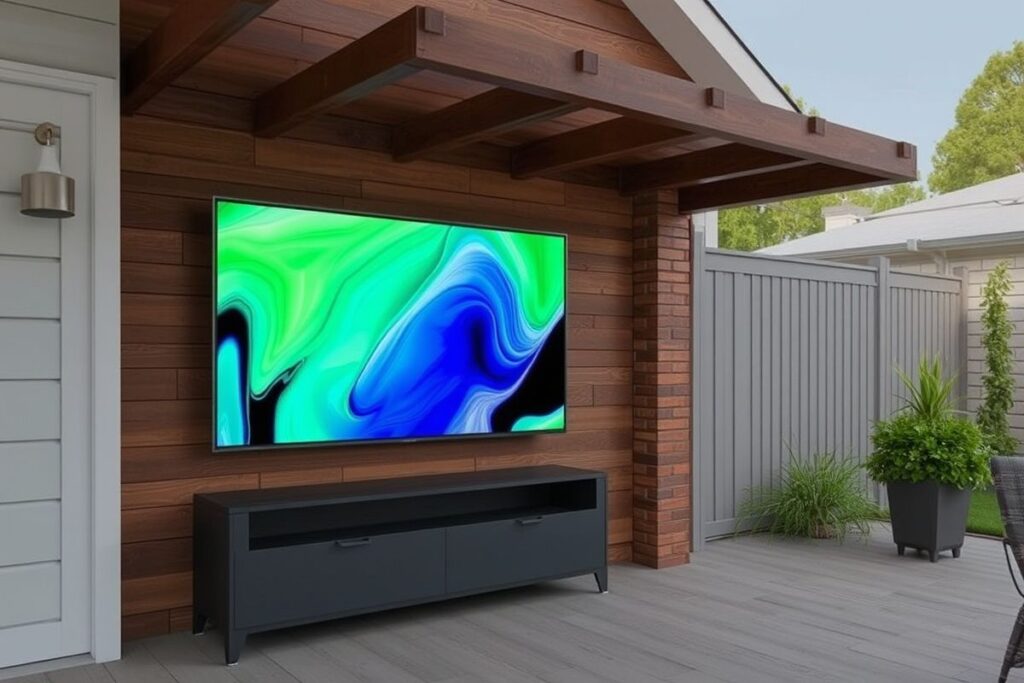Imagine this: you’ve invested in an outdoor TV, envisioning backyard movie nights and epic sports viewing. But after a few seasons, it’s plagued by weather damage. Choosing a durable outdoor TV is crucial for long-term enjoyment. This guide explores five key factors to consider when evaluating the durability of outdoor TVs, ensuring your investment withstands the elements and provides years of entertainment. From weatherproofing to screen protection, we’ll cover everything you need to know to make an informed decision. Don’t let your outdoor entertainment dreams fade away – learn how to choose a TV that can truly weather the storm.

Weatherproofing: The First Line of Defense
Ingress Protection (IP) Ratings Explained
Understanding IP ratings is fundamental when assessing weather resistance. These ratings consist of two digits: the first indicates protection against solids, and the second against liquids. Look for TVs with an IP rating of at least IP55, signifying protection against dust and low-pressure water jets. Higher ratings like IP65 offer even greater protection against dust and water, ensuring your TV can withstand harsher conditions.
A higher IP rating generally indicates better protection against the elements. However, it’s essential to consider the specific environmental challenges your TV will face. Coastal areas with salt spray may require higher liquid ingress protection than inland locations.
Always check the manufacturer’s specifications for detailed information on the TV’s weatherproofing capabilities. This information will often provide specific details about the types of weather conditions the TV is designed to withstand.
Material Matters: Choosing the Right Casing
The TV’s casing plays a crucial role in its durability. Look for robust materials like aluminum or high-impact plastics that can withstand temperature fluctuations and impacts. A well-designed casing should also provide adequate ventilation to prevent overheating, a common issue with outdoor electronics.
Consider the finish of the casing as well. A powder-coated finish provides added protection against corrosion and UV damage, extending the lifespan of your outdoor TV.
Examine the seams and seals of the casing. Tightly sealed seams prevent water and dust from entering the internal components, protecting the TV from damage.
Protecting Internal Components
While the exterior casing provides the first line of defense, protecting the internal components is equally important. Look for TVs with features like conformal coatings on circuit boards, which provide an extra layer of protection against moisture and corrosion. These coatings act as a barrier, preventing damage from humidity and condensation.
Ensure the TV is designed with proper drainage channels. These channels allow any water that does enter the casing to escape, preventing it from pooling around sensitive electronics. This is crucial for preventing water damage.
Check for internal fans or ventilation systems. Proper ventilation helps to regulate the internal temperature of the TV, preventing overheating, which can significantly shorten the lifespan of electronic components.
Screen Durability: Protecting Your View
Impact and Scratch Resistance
Outdoor TVs are susceptible to impacts from debris and accidental bumps. Look for screens made from tempered glass or other impact-resistant materials. These materials offer greater protection against cracking and shattering compared to standard glass.
Consider a screen with an anti-reflective coating. This coating not only reduces glare but also provides an additional layer of protection against scratches and abrasions.
Check for manufacturer warranties that cover screen damage. A comprehensive warranty can provide peace of mind, knowing you’re protected against unexpected repairs or replacements.
Anti-Glare and Brightness
Sunlight can wash out the image on an outdoor TV. Opt for a screen with high brightness and anti-glare properties to ensure optimal viewing even in direct sunlight. A bright screen and effective anti-glare technology will significantly enhance your viewing experience.
Look for TVs with adjustable brightness settings. This allows you to customize the brightness based on the ambient light conditions, ensuring optimal picture quality in various environments.
Consider the screen’s viewing angle. A wider viewing angle allows viewers to enjoy a clear picture from various positions, enhancing the overall viewing experience for everyone.

Leave a Reply